University Article Appraisal for Nursing Practice GDN3985
VerifiedAdded on 2022/12/30
|11
|3300
|53
Report
AI Summary
This report provides a comprehensive appraisal of a nursing research article focusing on pressure ulcer prevention, specifically analyzing a systematic review. The introduction effectively establishes the research context, highlighting the value of the study and its relevance for clinical care. The report examines the literature search, emphasizing the use of rigorous inclusion/exclusion criteria and the importance of evidence-based approaches, particularly randomized controlled trials. The quality of the review is assessed through the JBI-MAStARI tool. The data synthesis is discussed, including the challenges of heterogeneous studies and the use of narrative presentation. The results are presented thematically, and a detailed summary of the reviewed studies is provided. The findings are based on NPUAP, EPUAP, and PPPIA guidelines, with a 95% confidence level reported. The discussion emphasizes the application of the findings and the limitations of the study. Overall, the report offers a critical evaluation of the research article, providing insights into its strengths and weaknesses, and its implications for nursing practice.

Running head: ARTICLE APPRAISAL
1
Article Appraisal
University
Date
1
Article Appraisal
University
Date
Paraphrase This Document
Need a fresh take? Get an instant paraphrase of this document with our AI Paraphraser

ARTICLE APPRAISAL
2
Article Appraisal
Introduction
Tayyib & Coyer (2016) have adequately introduced the research topic by presenting basic
information on the topic. The role of an introduction in research is to provide preliminary
background information so that the research can be put in context. This implies that the
introduction clarifies the study, points out the value of the research by looking at gaps that exist
in the field of study and the same time allowing the reader to understand the research aims and
objectives (Sudheesh, Duggappa, & Nethra, 2016). By presenting the background information on
the topic well, the authors have clearly defined the value of the research by suggesting that the
information from this study will be used as a reference for caregivers and professionals in
clinical care.
The focus of this study was based on previous research studies that had been done on the
topic with a single prevention strategy for pressure ulcers. The population under study was adult
patients who had been admitted inwards or care facilities. For a study to be effective, the
researcher must identify a population niche or cohort that meets the requirements of the topic.
According to Martínez-Mesa, González-Chica, Duquia, Bonamigo, & Bastos (2016) suggests
that in research, the appropriateness of the study population is related to the effectiveness of the
sample and the results of the study. This means that the researcher needs to pick a population
sample that reflects the needs of the study. This study was based on research articles that meet
the requirements of adult population patients. Thus the appropriateness of the study was based on
the researchers picking the right articles for use in the systematic review.
Literature search/ review
2
Article Appraisal
Introduction
Tayyib & Coyer (2016) have adequately introduced the research topic by presenting basic
information on the topic. The role of an introduction in research is to provide preliminary
background information so that the research can be put in context. This implies that the
introduction clarifies the study, points out the value of the research by looking at gaps that exist
in the field of study and the same time allowing the reader to understand the research aims and
objectives (Sudheesh, Duggappa, & Nethra, 2016). By presenting the background information on
the topic well, the authors have clearly defined the value of the research by suggesting that the
information from this study will be used as a reference for caregivers and professionals in
clinical care.
The focus of this study was based on previous research studies that had been done on the
topic with a single prevention strategy for pressure ulcers. The population under study was adult
patients who had been admitted inwards or care facilities. For a study to be effective, the
researcher must identify a population niche or cohort that meets the requirements of the topic.
According to Martínez-Mesa, González-Chica, Duquia, Bonamigo, & Bastos (2016) suggests
that in research, the appropriateness of the study population is related to the effectiveness of the
sample and the results of the study. This means that the researcher needs to pick a population
sample that reflects the needs of the study. This study was based on research articles that meet
the requirements of adult population patients. Thus the appropriateness of the study was based on
the researchers picking the right articles for use in the systematic review.
Literature search/ review
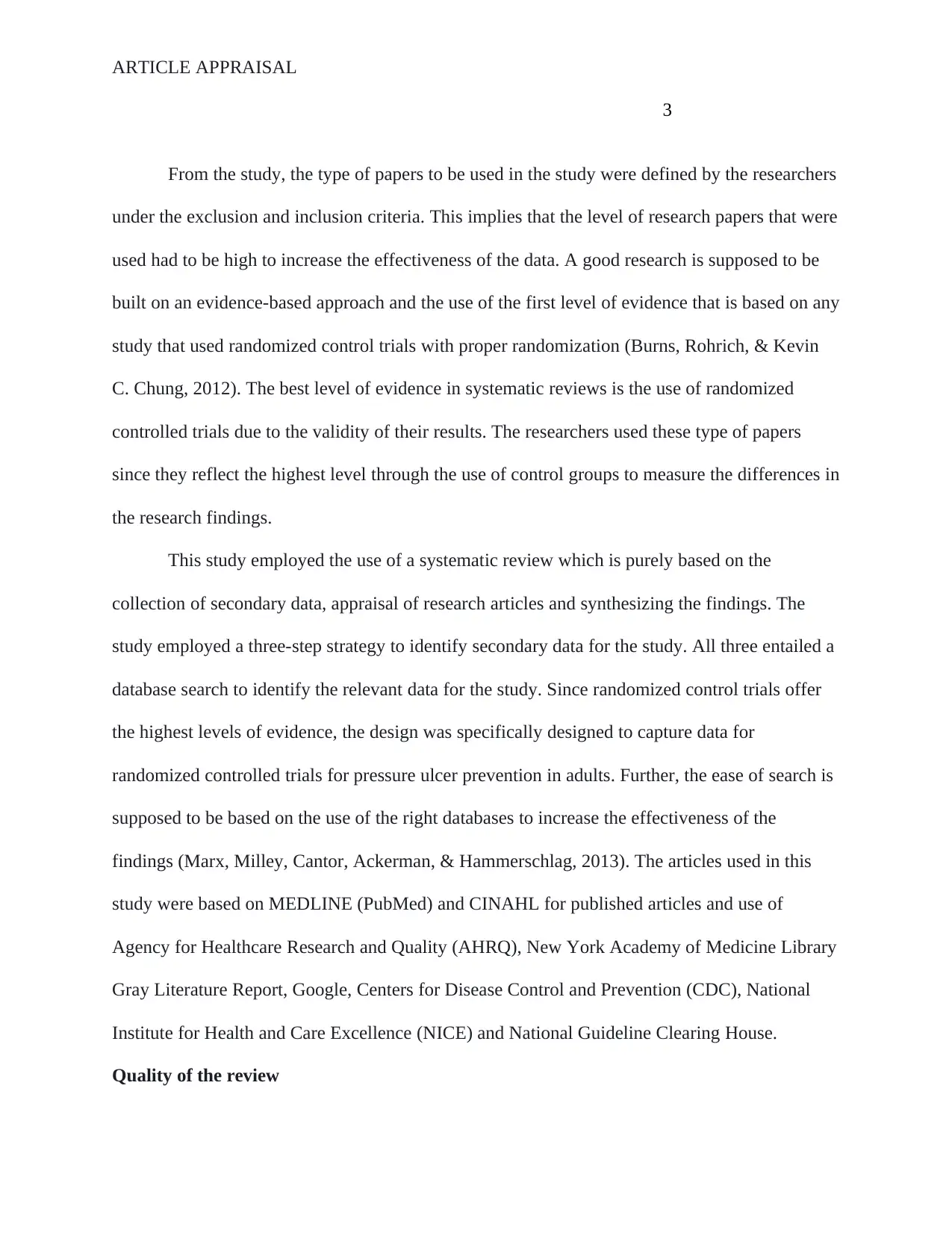
ARTICLE APPRAISAL
3
From the study, the type of papers to be used in the study were defined by the researchers
under the exclusion and inclusion criteria. This implies that the level of research papers that were
used had to be high to increase the effectiveness of the data. A good research is supposed to be
built on an evidence-based approach and the use of the first level of evidence that is based on any
study that used randomized control trials with proper randomization (Burns, Rohrich, & Kevin
C. Chung, 2012). The best level of evidence in systematic reviews is the use of randomized
controlled trials due to the validity of their results. The researchers used these type of papers
since they reflect the highest level through the use of control groups to measure the differences in
the research findings.
This study employed the use of a systematic review which is purely based on the
collection of secondary data, appraisal of research articles and synthesizing the findings. The
study employed a three-step strategy to identify secondary data for the study. All three entailed a
database search to identify the relevant data for the study. Since randomized control trials offer
the highest levels of evidence, the design was specifically designed to capture data for
randomized controlled trials for pressure ulcer prevention in adults. Further, the ease of search is
supposed to be based on the use of the right databases to increase the effectiveness of the
findings (Marx, Milley, Cantor, Ackerman, & Hammerschlag, 2013). The articles used in this
study were based on MEDLINE (PubMed) and CINAHL for published articles and use of
Agency for Healthcare Research and Quality (AHRQ), New York Academy of Medicine Library
Gray Literature Report, Google, Centers for Disease Control and Prevention (CDC), National
Institute for Health and Care Excellence (NICE) and National Guideline Clearing House.
Quality of the review
3
From the study, the type of papers to be used in the study were defined by the researchers
under the exclusion and inclusion criteria. This implies that the level of research papers that were
used had to be high to increase the effectiveness of the data. A good research is supposed to be
built on an evidence-based approach and the use of the first level of evidence that is based on any
study that used randomized control trials with proper randomization (Burns, Rohrich, & Kevin
C. Chung, 2012). The best level of evidence in systematic reviews is the use of randomized
controlled trials due to the validity of their results. The researchers used these type of papers
since they reflect the highest level through the use of control groups to measure the differences in
the research findings.
This study employed the use of a systematic review which is purely based on the
collection of secondary data, appraisal of research articles and synthesizing the findings. The
study employed a three-step strategy to identify secondary data for the study. All three entailed a
database search to identify the relevant data for the study. Since randomized control trials offer
the highest levels of evidence, the design was specifically designed to capture data for
randomized controlled trials for pressure ulcer prevention in adults. Further, the ease of search is
supposed to be based on the use of the right databases to increase the effectiveness of the
findings (Marx, Milley, Cantor, Ackerman, & Hammerschlag, 2013). The articles used in this
study were based on MEDLINE (PubMed) and CINAHL for published articles and use of
Agency for Healthcare Research and Quality (AHRQ), New York Academy of Medicine Library
Gray Literature Report, Google, Centers for Disease Control and Prevention (CDC), National
Institute for Health and Care Excellence (NICE) and National Guideline Clearing House.
Quality of the review
⊘ This is a preview!⊘
Do you want full access?
Subscribe today to unlock all pages.

Trusted by 1+ million students worldwide
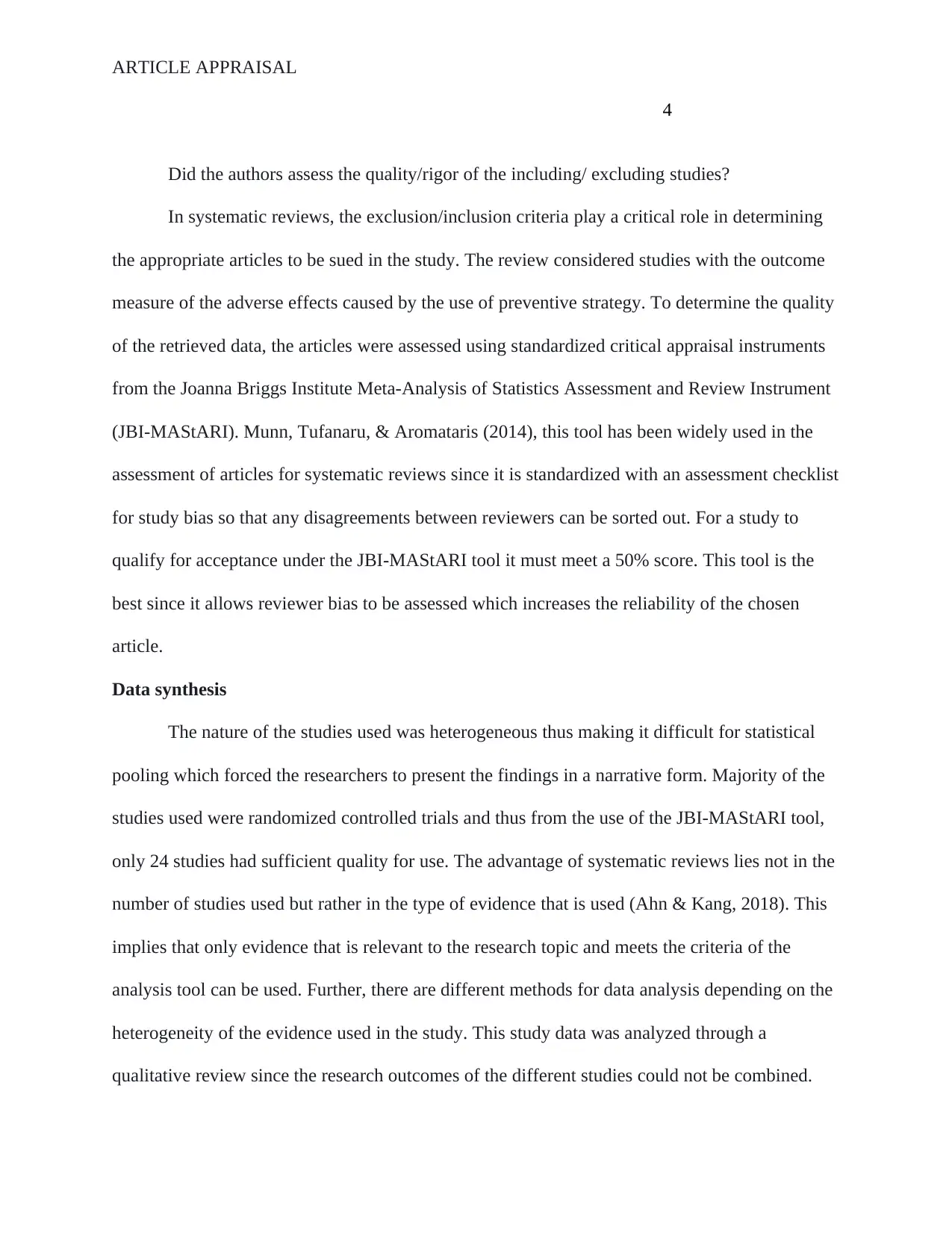
ARTICLE APPRAISAL
4
Did the authors assess the quality/rigor of the including/ excluding studies?
In systematic reviews, the exclusion/inclusion criteria play a critical role in determining
the appropriate articles to be sued in the study. The review considered studies with the outcome
measure of the adverse effects caused by the use of preventive strategy. To determine the quality
of the retrieved data, the articles were assessed using standardized critical appraisal instruments
from the Joanna Briggs Institute Meta-Analysis of Statistics Assessment and Review Instrument
(JBI-MAStARI). Munn, Tufanaru, & Aromataris (2014), this tool has been widely used in the
assessment of articles for systematic reviews since it is standardized with an assessment checklist
for study bias so that any disagreements between reviewers can be sorted out. For a study to
qualify for acceptance under the JBI-MAStARI tool it must meet a 50% score. This tool is the
best since it allows reviewer bias to be assessed which increases the reliability of the chosen
article.
Data synthesis
The nature of the studies used was heterogeneous thus making it difficult for statistical
pooling which forced the researchers to present the findings in a narrative form. Majority of the
studies used were randomized controlled trials and thus from the use of the JBI-MAStARI tool,
only 24 studies had sufficient quality for use. The advantage of systematic reviews lies not in the
number of studies used but rather in the type of evidence that is used (Ahn & Kang, 2018). This
implies that only evidence that is relevant to the research topic and meets the criteria of the
analysis tool can be used. Further, there are different methods for data analysis depending on the
heterogeneity of the evidence used in the study. This study data was analyzed through a
qualitative review since the research outcomes of the different studies could not be combined.
4
Did the authors assess the quality/rigor of the including/ excluding studies?
In systematic reviews, the exclusion/inclusion criteria play a critical role in determining
the appropriate articles to be sued in the study. The review considered studies with the outcome
measure of the adverse effects caused by the use of preventive strategy. To determine the quality
of the retrieved data, the articles were assessed using standardized critical appraisal instruments
from the Joanna Briggs Institute Meta-Analysis of Statistics Assessment and Review Instrument
(JBI-MAStARI). Munn, Tufanaru, & Aromataris (2014), this tool has been widely used in the
assessment of articles for systematic reviews since it is standardized with an assessment checklist
for study bias so that any disagreements between reviewers can be sorted out. For a study to
qualify for acceptance under the JBI-MAStARI tool it must meet a 50% score. This tool is the
best since it allows reviewer bias to be assessed which increases the reliability of the chosen
article.
Data synthesis
The nature of the studies used was heterogeneous thus making it difficult for statistical
pooling which forced the researchers to present the findings in a narrative form. Majority of the
studies used were randomized controlled trials and thus from the use of the JBI-MAStARI tool,
only 24 studies had sufficient quality for use. The advantage of systematic reviews lies not in the
number of studies used but rather in the type of evidence that is used (Ahn & Kang, 2018). This
implies that only evidence that is relevant to the research topic and meets the criteria of the
analysis tool can be used. Further, there are different methods for data analysis depending on the
heterogeneity of the evidence used in the study. This study data was analyzed through a
qualitative review since the research outcomes of the different studies could not be combined.
Paraphrase This Document
Need a fresh take? Get an instant paraphrase of this document with our AI Paraphraser
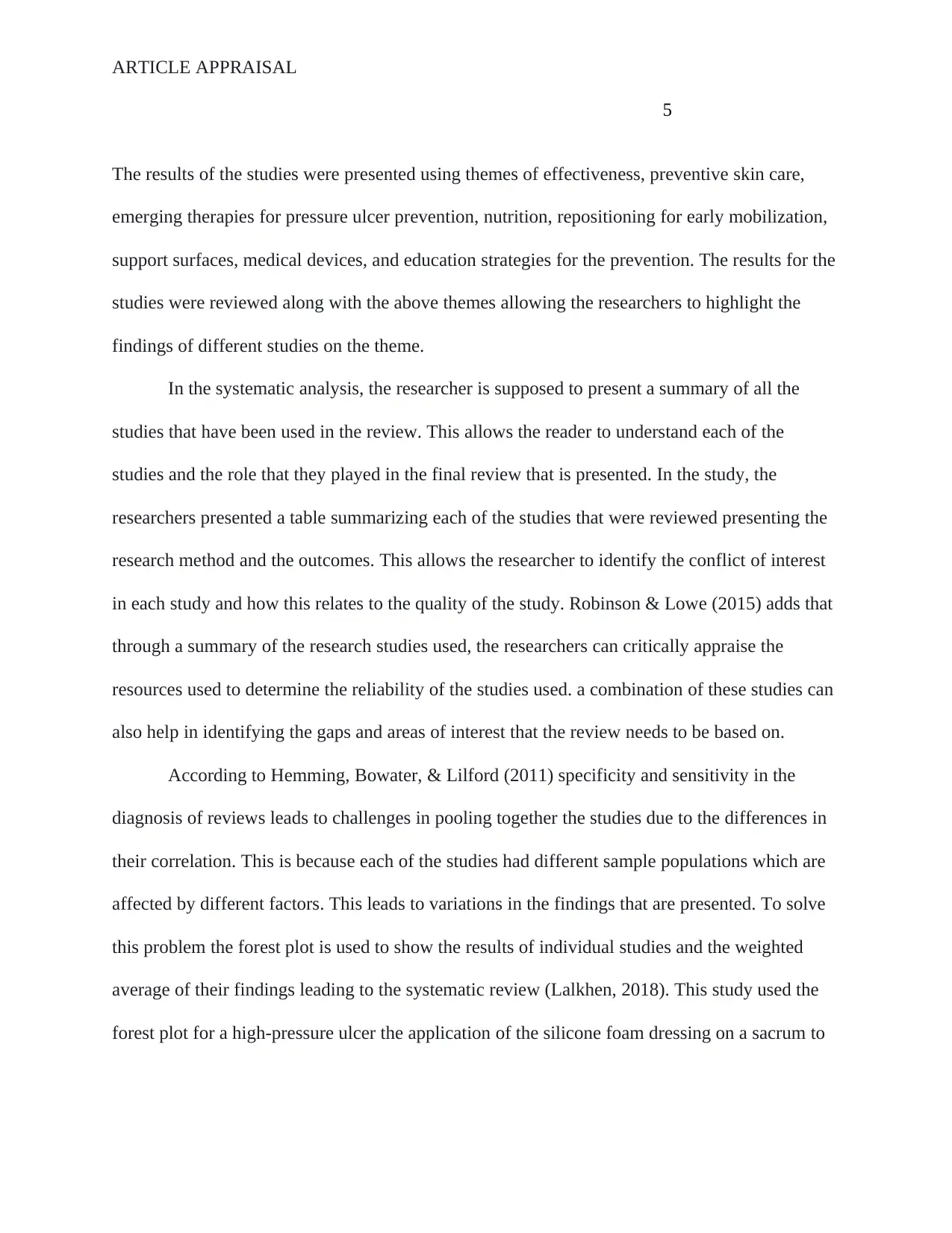
ARTICLE APPRAISAL
5
The results of the studies were presented using themes of effectiveness, preventive skin care,
emerging therapies for pressure ulcer prevention, nutrition, repositioning for early mobilization,
support surfaces, medical devices, and education strategies for the prevention. The results for the
studies were reviewed along with the above themes allowing the researchers to highlight the
findings of different studies on the theme.
In the systematic analysis, the researcher is supposed to present a summary of all the
studies that have been used in the review. This allows the reader to understand each of the
studies and the role that they played in the final review that is presented. In the study, the
researchers presented a table summarizing each of the studies that were reviewed presenting the
research method and the outcomes. This allows the researcher to identify the conflict of interest
in each study and how this relates to the quality of the study. Robinson & Lowe (2015) adds that
through a summary of the research studies used, the researchers can critically appraise the
resources used to determine the reliability of the studies used. a combination of these studies can
also help in identifying the gaps and areas of interest that the review needs to be based on.
According to Hemming, Bowater, & Lilford (2011) specificity and sensitivity in the
diagnosis of reviews leads to challenges in pooling together the studies due to the differences in
their correlation. This is because each of the studies had different sample populations which are
affected by different factors. This leads to variations in the findings that are presented. To solve
this problem the forest plot is used to show the results of individual studies and the weighted
average of their findings leading to the systematic review (Lalkhen, 2018). This study used the
forest plot for a high-pressure ulcer the application of the silicone foam dressing on a sacrum to
5
The results of the studies were presented using themes of effectiveness, preventive skin care,
emerging therapies for pressure ulcer prevention, nutrition, repositioning for early mobilization,
support surfaces, medical devices, and education strategies for the prevention. The results for the
studies were reviewed along with the above themes allowing the researchers to highlight the
findings of different studies on the theme.
In the systematic analysis, the researcher is supposed to present a summary of all the
studies that have been used in the review. This allows the reader to understand each of the
studies and the role that they played in the final review that is presented. In the study, the
researchers presented a table summarizing each of the studies that were reviewed presenting the
research method and the outcomes. This allows the researcher to identify the conflict of interest
in each study and how this relates to the quality of the study. Robinson & Lowe (2015) adds that
through a summary of the research studies used, the researchers can critically appraise the
resources used to determine the reliability of the studies used. a combination of these studies can
also help in identifying the gaps and areas of interest that the review needs to be based on.
According to Hemming, Bowater, & Lilford (2011) specificity and sensitivity in the
diagnosis of reviews leads to challenges in pooling together the studies due to the differences in
their correlation. This is because each of the studies had different sample populations which are
affected by different factors. This leads to variations in the findings that are presented. To solve
this problem the forest plot is used to show the results of individual studies and the weighted
average of their findings leading to the systematic review (Lalkhen, 2018). This study used the
forest plot for a high-pressure ulcer the application of the silicone foam dressing on a sacrum to

ARTICLE APPRAISAL
6
determine the odd ratio between the studies. This allows the researcher to pick the studies that
present a high confidence level to form the basis of the systematic study.
Results
The findings of the study were based on the requirements of NPUAP, EPUAP, and
PPPIA guideline (2014) guidelines. From the study, no study examined the effectiveness of skin
and tissue risk assessment. One study compared three strategies of bowel management to control
the development of pressure ulcers. On the theme of emerging therapies, one study was found on
polarized light and three for dressings to show the emerging therapies for pressure ulcer
prevention. On the theme of nutrition, one study focused on nutritional strategies to prevent
pressure ulcer development, two studies focused on repositioning and early mobilization as a
way of preventing pressure ulcers, six studies focused on the efficacy of support surfaces and
lastly one study was emphasized the use of educational approaches for prevention of pressure
ulcers in patients. Tayyib & Coyer (2016) study summarized the research articles using the
above themes as a guide to present what the studies entailed.
The precision of results in any study depends on the confidence level that is reported in
the study. This refers to the percentage of possible samples that can be expected by including the
population parameter. Since this is calculated based on the statistical measures of distribution, it
assists in concluding in the face of uncertainty by reflecting the true measure of the population.
This is expressed as a percentage with the lowest being set at 95% which is the level of
confidence that a study was based on its findings. The confidence level of this study has been
expressed in the forest plot which has been reported at 95%. This implies that the systematic
review has a 95% reliability chance of being true thus meeting the requirements of NPUAP,
6
determine the odd ratio between the studies. This allows the researcher to pick the studies that
present a high confidence level to form the basis of the systematic study.
Results
The findings of the study were based on the requirements of NPUAP, EPUAP, and
PPPIA guideline (2014) guidelines. From the study, no study examined the effectiveness of skin
and tissue risk assessment. One study compared three strategies of bowel management to control
the development of pressure ulcers. On the theme of emerging therapies, one study was found on
polarized light and three for dressings to show the emerging therapies for pressure ulcer
prevention. On the theme of nutrition, one study focused on nutritional strategies to prevent
pressure ulcer development, two studies focused on repositioning and early mobilization as a
way of preventing pressure ulcers, six studies focused on the efficacy of support surfaces and
lastly one study was emphasized the use of educational approaches for prevention of pressure
ulcers in patients. Tayyib & Coyer (2016) study summarized the research articles using the
above themes as a guide to present what the studies entailed.
The precision of results in any study depends on the confidence level that is reported in
the study. This refers to the percentage of possible samples that can be expected by including the
population parameter. Since this is calculated based on the statistical measures of distribution, it
assists in concluding in the face of uncertainty by reflecting the true measure of the population.
This is expressed as a percentage with the lowest being set at 95% which is the level of
confidence that a study was based on its findings. The confidence level of this study has been
expressed in the forest plot which has been reported at 95%. This implies that the systematic
review has a 95% reliability chance of being true thus meeting the requirements of NPUAP,
⊘ This is a preview!⊘
Do you want full access?
Subscribe today to unlock all pages.

Trusted by 1+ million students worldwide
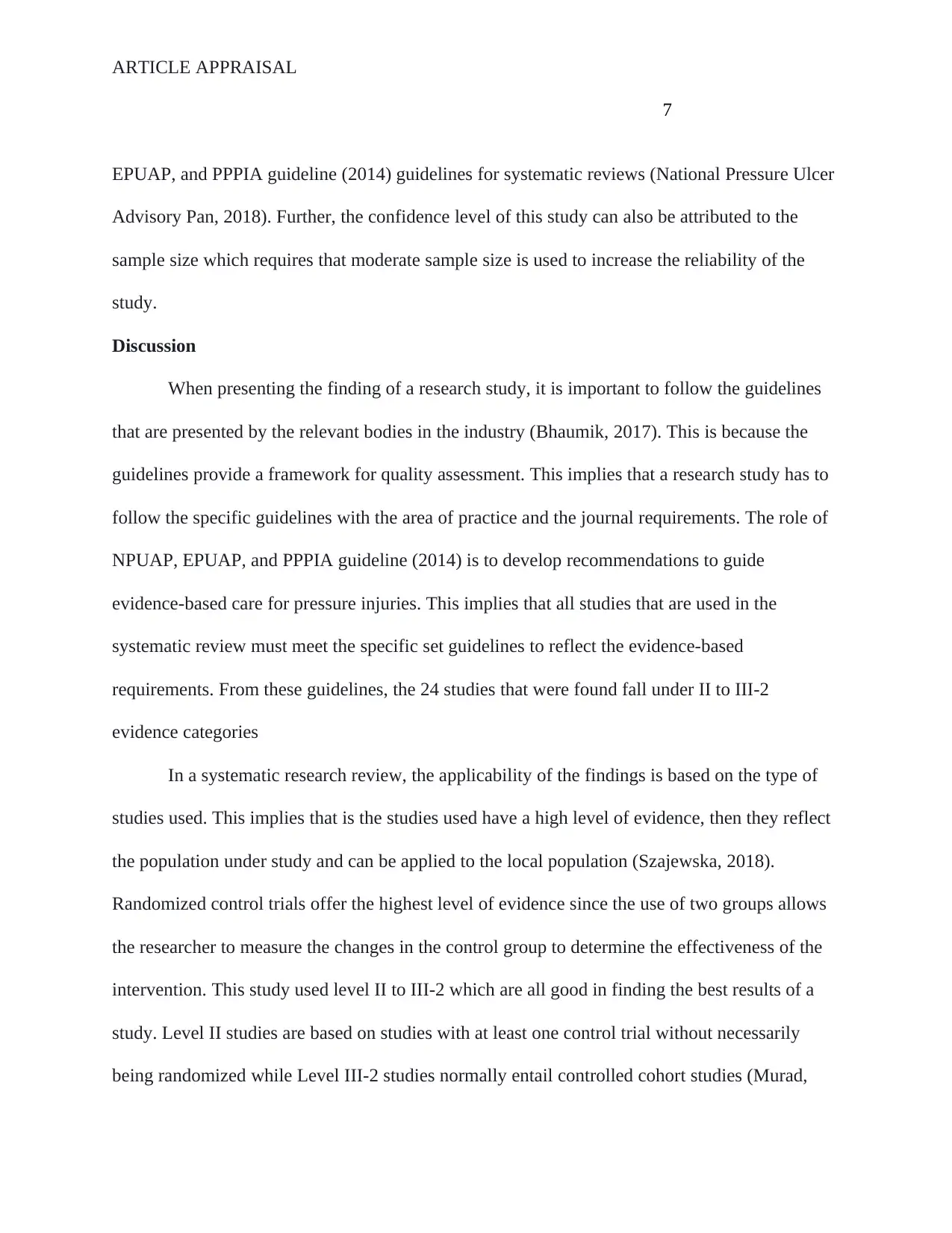
ARTICLE APPRAISAL
7
EPUAP, and PPPIA guideline (2014) guidelines for systematic reviews (National Pressure Ulcer
Advisory Pan, 2018). Further, the confidence level of this study can also be attributed to the
sample size which requires that moderate sample size is used to increase the reliability of the
study.
Discussion
When presenting the finding of a research study, it is important to follow the guidelines
that are presented by the relevant bodies in the industry (Bhaumik, 2017). This is because the
guidelines provide a framework for quality assessment. This implies that a research study has to
follow the specific guidelines with the area of practice and the journal requirements. The role of
NPUAP, EPUAP, and PPPIA guideline (2014) is to develop recommendations to guide
evidence-based care for pressure injuries. This implies that all studies that are used in the
systematic review must meet the specific set guidelines to reflect the evidence-based
requirements. From these guidelines, the 24 studies that were found fall under II to III-2
evidence categories
In a systematic research review, the applicability of the findings is based on the type of
studies used. This implies that is the studies used have a high level of evidence, then they reflect
the population under study and can be applied to the local population (Szajewska, 2018).
Randomized control trials offer the highest level of evidence since the use of two groups allows
the researcher to measure the changes in the control group to determine the effectiveness of the
intervention. This study used level II to III-2 which are all good in finding the best results of a
study. Level II studies are based on studies with at least one control trial without necessarily
being randomized while Level III-2 studies normally entail controlled cohort studies (Murad,
7
EPUAP, and PPPIA guideline (2014) guidelines for systematic reviews (National Pressure Ulcer
Advisory Pan, 2018). Further, the confidence level of this study can also be attributed to the
sample size which requires that moderate sample size is used to increase the reliability of the
study.
Discussion
When presenting the finding of a research study, it is important to follow the guidelines
that are presented by the relevant bodies in the industry (Bhaumik, 2017). This is because the
guidelines provide a framework for quality assessment. This implies that a research study has to
follow the specific guidelines with the area of practice and the journal requirements. The role of
NPUAP, EPUAP, and PPPIA guideline (2014) is to develop recommendations to guide
evidence-based care for pressure injuries. This implies that all studies that are used in the
systematic review must meet the specific set guidelines to reflect the evidence-based
requirements. From these guidelines, the 24 studies that were found fall under II to III-2
evidence categories
In a systematic research review, the applicability of the findings is based on the type of
studies used. This implies that is the studies used have a high level of evidence, then they reflect
the population under study and can be applied to the local population (Szajewska, 2018).
Randomized control trials offer the highest level of evidence since the use of two groups allows
the researcher to measure the changes in the control group to determine the effectiveness of the
intervention. This study used level II to III-2 which are all good in finding the best results of a
study. Level II studies are based on studies with at least one control trial without necessarily
being randomized while Level III-2 studies normally entail controlled cohort studies (Murad,
Paraphrase This Document
Need a fresh take? Get an instant paraphrase of this document with our AI Paraphraser
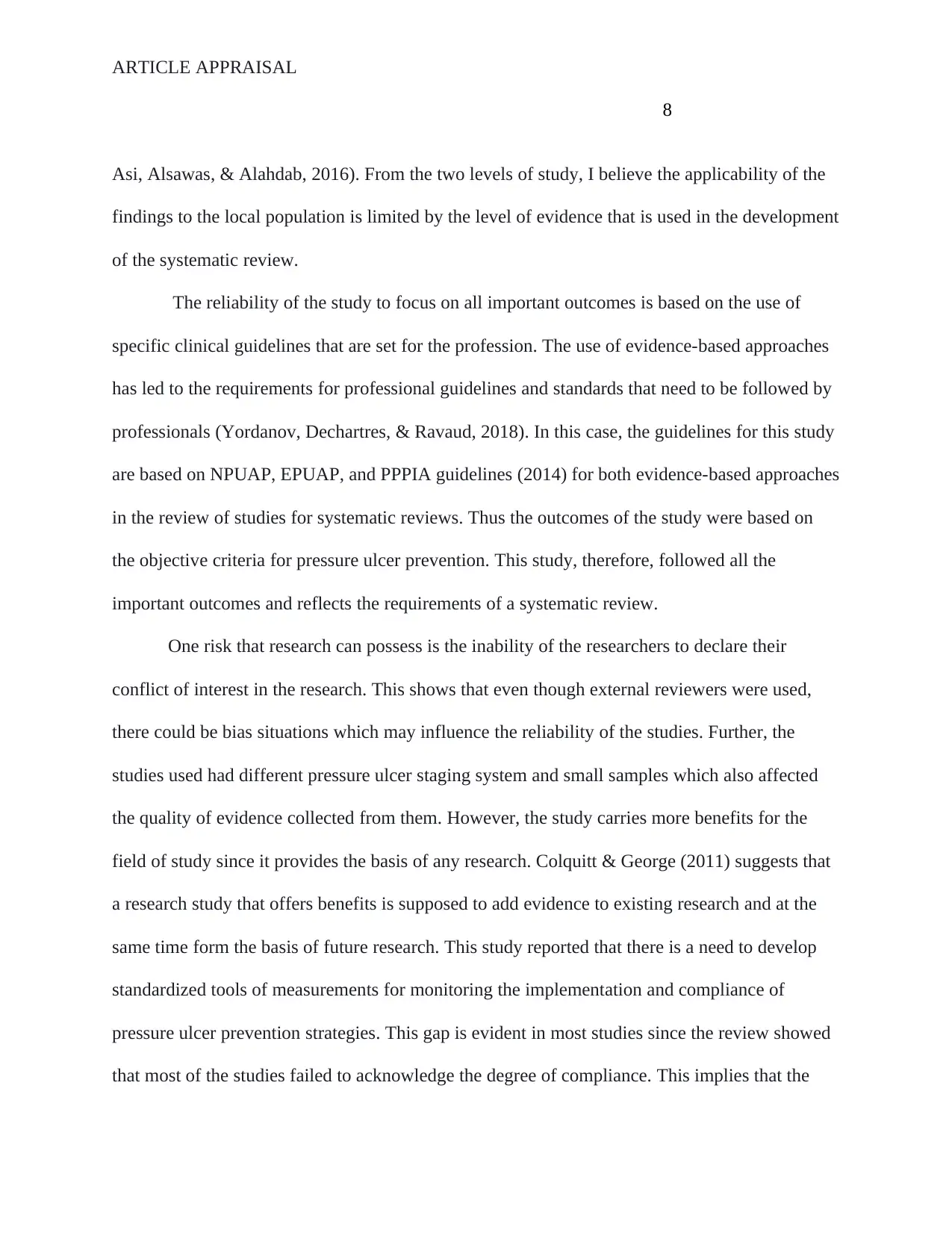
ARTICLE APPRAISAL
8
Asi, Alsawas, & Alahdab, 2016). From the two levels of study, I believe the applicability of the
findings to the local population is limited by the level of evidence that is used in the development
of the systematic review.
The reliability of the study to focus on all important outcomes is based on the use of
specific clinical guidelines that are set for the profession. The use of evidence-based approaches
has led to the requirements for professional guidelines and standards that need to be followed by
professionals (Yordanov, Dechartres, & Ravaud, 2018). In this case, the guidelines for this study
are based on NPUAP, EPUAP, and PPPIA guidelines (2014) for both evidence-based approaches
in the review of studies for systematic reviews. Thus the outcomes of the study were based on
the objective criteria for pressure ulcer prevention. This study, therefore, followed all the
important outcomes and reflects the requirements of a systematic review.
One risk that research can possess is the inability of the researchers to declare their
conflict of interest in the research. This shows that even though external reviewers were used,
there could be bias situations which may influence the reliability of the studies. Further, the
studies used had different pressure ulcer staging system and small samples which also affected
the quality of evidence collected from them. However, the study carries more benefits for the
field of study since it provides the basis of any research. Colquitt & George (2011) suggests that
a research study that offers benefits is supposed to add evidence to existing research and at the
same time form the basis of future research. This study reported that there is a need to develop
standardized tools of measurements for monitoring the implementation and compliance of
pressure ulcer prevention strategies. This gap is evident in most studies since the review showed
that most of the studies failed to acknowledge the degree of compliance. This implies that the
8
Asi, Alsawas, & Alahdab, 2016). From the two levels of study, I believe the applicability of the
findings to the local population is limited by the level of evidence that is used in the development
of the systematic review.
The reliability of the study to focus on all important outcomes is based on the use of
specific clinical guidelines that are set for the profession. The use of evidence-based approaches
has led to the requirements for professional guidelines and standards that need to be followed by
professionals (Yordanov, Dechartres, & Ravaud, 2018). In this case, the guidelines for this study
are based on NPUAP, EPUAP, and PPPIA guidelines (2014) for both evidence-based approaches
in the review of studies for systematic reviews. Thus the outcomes of the study were based on
the objective criteria for pressure ulcer prevention. This study, therefore, followed all the
important outcomes and reflects the requirements of a systematic review.
One risk that research can possess is the inability of the researchers to declare their
conflict of interest in the research. This shows that even though external reviewers were used,
there could be bias situations which may influence the reliability of the studies. Further, the
studies used had different pressure ulcer staging system and small samples which also affected
the quality of evidence collected from them. However, the study carries more benefits for the
field of study since it provides the basis of any research. Colquitt & George (2011) suggests that
a research study that offers benefits is supposed to add evidence to existing research and at the
same time form the basis of future research. This study reported that there is a need to develop
standardized tools of measurements for monitoring the implementation and compliance of
pressure ulcer prevention strategies. This gap is evident in most studies since the review showed
that most of the studies failed to acknowledge the degree of compliance. This implies that the

ARTICLE APPRAISAL
9
basis of future research needs to be based on the need to develop more effective pressure ulcer
prevention guidelines for guiding clinical users.
Conclusion
This research has been limited by the level of evidence that was used in the studies that
were extracted from the literature search. The use of level II & II evidence creates challenges in
the applicability of the study findings. Even though the authors followed NPUAP, EPUAP, and
PPPIA guidelines (2014) guidelines, the limitations of the study make it difficult to be
generalized to the whole industry. However, the authors have proposed recommendations for
future research based on the need to develop more effective pressure ulcer prevention guidelines
for use in clinical settings. Thus this study forms the basis of future research to improve the
existing guidelines. Although the level of evidence used in this study is limited to the point that it
cannot be generalized to the industry, it forms the basis of future research by proposing research
directions that need to be taken. This calls for the need to investigate and report standardized
criteria for managing pressure ulcers. Since different themes have been identified in the study,
the authors propose the need for guidelines to be used in determining the best way to manage the
problem. Since this study did not conclude the effectiveness of the mentioned strategies in the
prevention of pressure ulcers, the implication for practice here is the need for further research
with consideration of multiple factors for assessing pressure ulcers to increase the reliability and
generalizability of the findings. This also needs to be based on rigorous randomized controlled
trials that considered the multiple factors within the area of study.
9
basis of future research needs to be based on the need to develop more effective pressure ulcer
prevention guidelines for guiding clinical users.
Conclusion
This research has been limited by the level of evidence that was used in the studies that
were extracted from the literature search. The use of level II & II evidence creates challenges in
the applicability of the study findings. Even though the authors followed NPUAP, EPUAP, and
PPPIA guidelines (2014) guidelines, the limitations of the study make it difficult to be
generalized to the whole industry. However, the authors have proposed recommendations for
future research based on the need to develop more effective pressure ulcer prevention guidelines
for use in clinical settings. Thus this study forms the basis of future research to improve the
existing guidelines. Although the level of evidence used in this study is limited to the point that it
cannot be generalized to the industry, it forms the basis of future research by proposing research
directions that need to be taken. This calls for the need to investigate and report standardized
criteria for managing pressure ulcers. Since different themes have been identified in the study,
the authors propose the need for guidelines to be used in determining the best way to manage the
problem. Since this study did not conclude the effectiveness of the mentioned strategies in the
prevention of pressure ulcers, the implication for practice here is the need for further research
with consideration of multiple factors for assessing pressure ulcers to increase the reliability and
generalizability of the findings. This also needs to be based on rigorous randomized controlled
trials that considered the multiple factors within the area of study.
⊘ This is a preview!⊘
Do you want full access?
Subscribe today to unlock all pages.

Trusted by 1+ million students worldwide
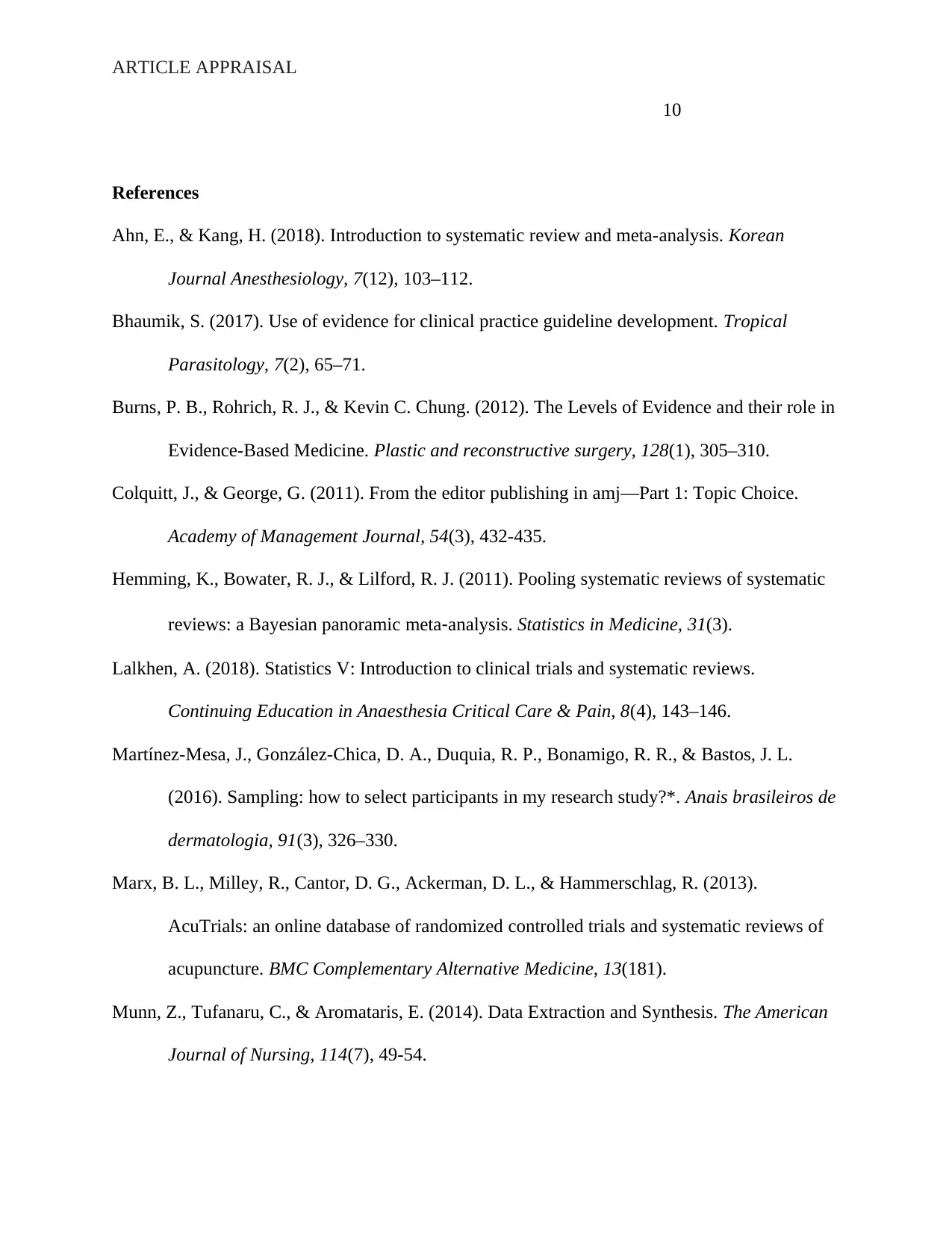
ARTICLE APPRAISAL
10
References
Ahn, E., & Kang, H. (2018). Introduction to systematic review and meta-analysis. Korean
Journal Anesthesiology, 7(12), 103–112.
Bhaumik, S. (2017). Use of evidence for clinical practice guideline development. Tropical
Parasitology, 7(2), 65–71.
Burns, P. B., Rohrich, R. J., & Kevin C. Chung. (2012). The Levels of Evidence and their role in
Evidence-Based Medicine. Plastic and reconstructive surgery, 128(1), 305–310.
Colquitt, J., & George, G. (2011). From the editor publishing in amj—Part 1: Topic Choice.
Academy of Management Journal, 54(3), 432-435.
Hemming, K., Bowater, R. J., & Lilford, R. J. (2011). Pooling systematic reviews of systematic
reviews: a Bayesian panoramic meta‐analysis. Statistics in Medicine, 31(3).
Lalkhen, A. (2018). Statistics V: Introduction to clinical trials and systematic reviews.
Continuing Education in Anaesthesia Critical Care & Pain, 8(4), 143–146.
Martínez-Mesa, J., González-Chica, D. A., Duquia, R. P., Bonamigo, R. R., & Bastos, J. L.
(2016). Sampling: how to select participants in my research study?*. Anais brasileiros de
dermatologia, 91(3), 326–330.
Marx, B. L., Milley, R., Cantor, D. G., Ackerman, D. L., & Hammerschlag, R. (2013).
AcuTrials: an online database of randomized controlled trials and systematic reviews of
acupuncture. BMC Complementary Alternative Medicine, 13(181).
Munn, Z., Tufanaru, C., & Aromataris, E. (2014). Data Extraction and Synthesis. The American
Journal of Nursing, 114(7), 49-54.
10
References
Ahn, E., & Kang, H. (2018). Introduction to systematic review and meta-analysis. Korean
Journal Anesthesiology, 7(12), 103–112.
Bhaumik, S. (2017). Use of evidence for clinical practice guideline development. Tropical
Parasitology, 7(2), 65–71.
Burns, P. B., Rohrich, R. J., & Kevin C. Chung. (2012). The Levels of Evidence and their role in
Evidence-Based Medicine. Plastic and reconstructive surgery, 128(1), 305–310.
Colquitt, J., & George, G. (2011). From the editor publishing in amj—Part 1: Topic Choice.
Academy of Management Journal, 54(3), 432-435.
Hemming, K., Bowater, R. J., & Lilford, R. J. (2011). Pooling systematic reviews of systematic
reviews: a Bayesian panoramic meta‐analysis. Statistics in Medicine, 31(3).
Lalkhen, A. (2018). Statistics V: Introduction to clinical trials and systematic reviews.
Continuing Education in Anaesthesia Critical Care & Pain, 8(4), 143–146.
Martínez-Mesa, J., González-Chica, D. A., Duquia, R. P., Bonamigo, R. R., & Bastos, J. L.
(2016). Sampling: how to select participants in my research study?*. Anais brasileiros de
dermatologia, 91(3), 326–330.
Marx, B. L., Milley, R., Cantor, D. G., Ackerman, D. L., & Hammerschlag, R. (2013).
AcuTrials: an online database of randomized controlled trials and systematic reviews of
acupuncture. BMC Complementary Alternative Medicine, 13(181).
Munn, Z., Tufanaru, C., & Aromataris, E. (2014). Data Extraction and Synthesis. The American
Journal of Nursing, 114(7), 49-54.
Paraphrase This Document
Need a fresh take? Get an instant paraphrase of this document with our AI Paraphraser
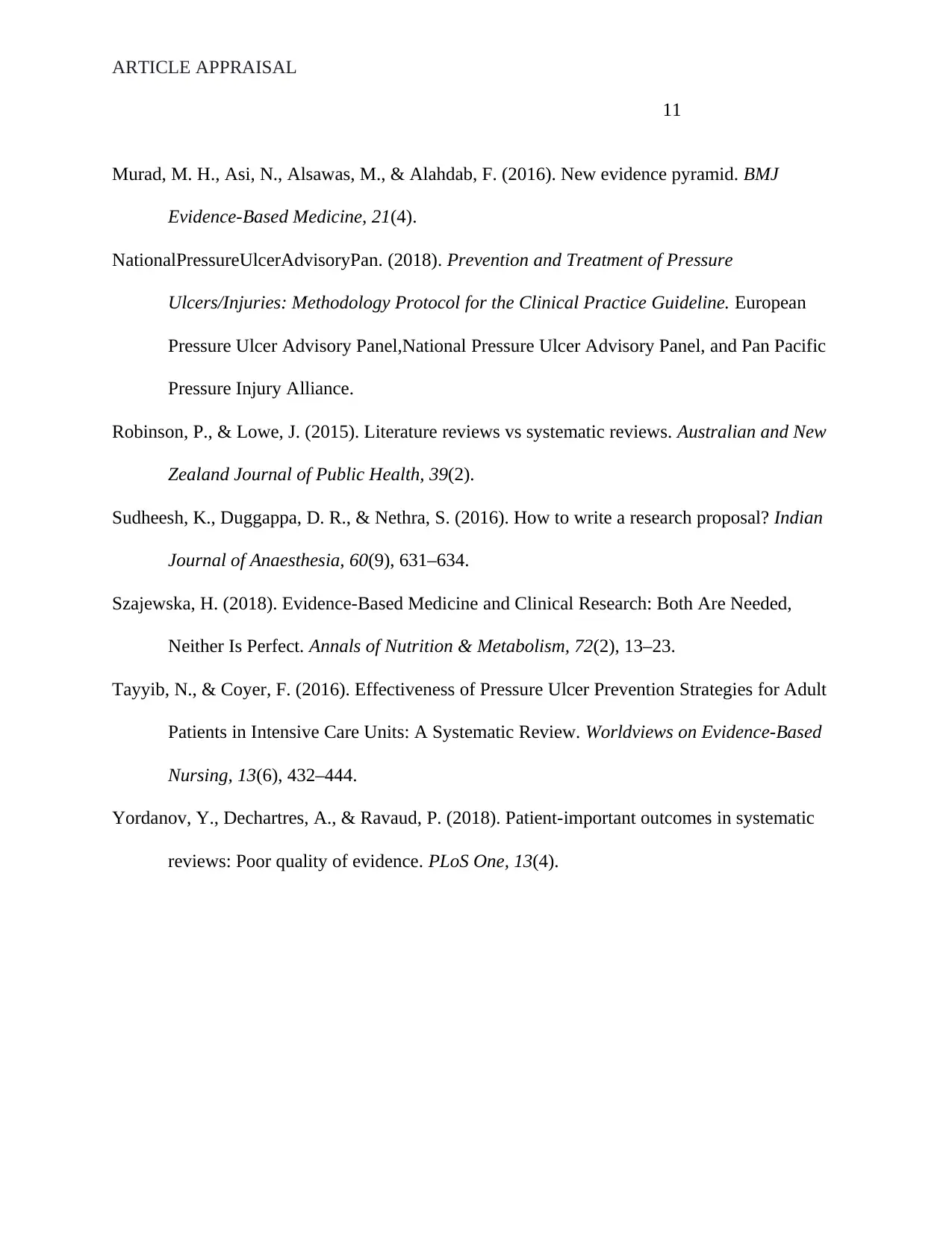
ARTICLE APPRAISAL
11
Murad, M. H., Asi, N., Alsawas, M., & Alahdab, F. (2016). New evidence pyramid. BMJ
Evidence-Based Medicine, 21(4).
NationalPressureUlcerAdvisoryPan. (2018). Prevention and Treatment of Pressure
Ulcers/Injuries: Methodology Protocol for the Clinical Practice Guideline. European
Pressure Ulcer Advisory Panel,National Pressure Ulcer Advisory Panel, and Pan Pacific
Pressure Injury Alliance.
Robinson, P., & Lowe, J. (2015). Literature reviews vs systematic reviews. Australian and New
Zealand Journal of Public Health, 39(2).
Sudheesh, K., Duggappa, D. R., & Nethra, S. (2016). How to write a research proposal? Indian
Journal of Anaesthesia, 60(9), 631–634.
Szajewska, H. (2018). Evidence-Based Medicine and Clinical Research: Both Are Needed,
Neither Is Perfect. Annals of Nutrition & Metabolism, 72(2), 13–23.
Tayyib, N., & Coyer, F. (2016). Effectiveness of Pressure Ulcer Prevention Strategies for Adult
Patients in Intensive Care Units: A Systematic Review. Worldviews on Evidence-Based
Nursing, 13(6), 432–444.
Yordanov, Y., Dechartres, A., & Ravaud, P. (2018). Patient-important outcomes in systematic
reviews: Poor quality of evidence. PLoS One, 13(4).
11
Murad, M. H., Asi, N., Alsawas, M., & Alahdab, F. (2016). New evidence pyramid. BMJ
Evidence-Based Medicine, 21(4).
NationalPressureUlcerAdvisoryPan. (2018). Prevention and Treatment of Pressure
Ulcers/Injuries: Methodology Protocol for the Clinical Practice Guideline. European
Pressure Ulcer Advisory Panel,National Pressure Ulcer Advisory Panel, and Pan Pacific
Pressure Injury Alliance.
Robinson, P., & Lowe, J. (2015). Literature reviews vs systematic reviews. Australian and New
Zealand Journal of Public Health, 39(2).
Sudheesh, K., Duggappa, D. R., & Nethra, S. (2016). How to write a research proposal? Indian
Journal of Anaesthesia, 60(9), 631–634.
Szajewska, H. (2018). Evidence-Based Medicine and Clinical Research: Both Are Needed,
Neither Is Perfect. Annals of Nutrition & Metabolism, 72(2), 13–23.
Tayyib, N., & Coyer, F. (2016). Effectiveness of Pressure Ulcer Prevention Strategies for Adult
Patients in Intensive Care Units: A Systematic Review. Worldviews on Evidence-Based
Nursing, 13(6), 432–444.
Yordanov, Y., Dechartres, A., & Ravaud, P. (2018). Patient-important outcomes in systematic
reviews: Poor quality of evidence. PLoS One, 13(4).
1 out of 11
Related Documents
Your All-in-One AI-Powered Toolkit for Academic Success.
+13062052269
info@desklib.com
Available 24*7 on WhatsApp / Email
![[object Object]](/_next/static/media/star-bottom.7253800d.svg)
Unlock your academic potential
Copyright © 2020–2025 A2Z Services. All Rights Reserved. Developed and managed by ZUCOL.





